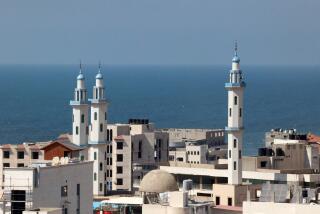BATTLES HITLER LOST: First Person Accounts of World War II by Russian Generals on the Eastern Front <i> (Richardson & Steirman: $27.50; 240 pp., illustrated)</i>
- Share via
“Battles Hitler Lost” is an odd and uneven piece of work. The military accounts presented have been culled without acknowledgment from the writings of Soviet World War II commanders, all of whom are dead, some for as long as 20 years. Nevertheless, these first-person accounts give the book strength. Georgi Zhukov, for example, describes his phone call to Stalin immediately after Hitler invaded: “I reported the situation and requested permission to start retaliation. Stalin was silent. The only thing I could hear was the sound of his breathing. ‘Do you understand me?’ Silence again . . . ‘Come to the Kremlin.’ . . . All the Politburo members were assembled. Stalin, his face white, was sitting at the table cradling a tobacco-filled pipe in his hand. After some time, he said, ‘We must phone the German embassy immediately.’ ” Such was Stalin’s reluctance to believe that Hitler would betray him.
In actuality, the Zhukov excerpt is a somewhat expurgated version of the 10th chapter of the marshal’s 1969 memoirs. Serious students should read the original, as many of the most interesting passages have been excised. For example, mentions of Khrushchev and some fascinating vignettes of Stalin have been cut.
Still, there are poignant and dramatic moments described in the present volume, as old soldiers tell their stories of saving Moscow, stopping the Germans at Stalingrad, fighting the greatest tank battle in history at Kursk, and breaking the siege of Leningrad. There are moving accounts of courage, compassion and endurance. The late-war tales are less interesting, as the outcome becomes less in doubt and the descriptions of unit deployments, numbers of guns, prisoner counts, and logistic arrangements increasingly dominate the text. As the 13th or 14th battle is recounted, the eyes of even an attentive reader begin to glaze over. In terms of style, these Soviet marshals will not push Leo Tolstoy from his pedestal.
This is largely a picture book, with a photograph on almost every page. Many of the shots are vivid and affecting--a starving and emaciated Leningrader holding his day’s ration of bread, a gun crew at the battle of Kursk, an old priest helping soldiers, a burned village, lamentations on the battle field, children, loved ones, the dead. A few pass over the line separating drama from obvious propaganda and, unfortunately, the reproduction of the pictures is not first class.
The Soviet authorities were ill served by their American publishers. They boast of 17 color maps, but the maps are terrible. Names in the text are generally not to be found on the maps. The color map supposed to match the campaign to drive the Germans from Riga and the Baltic states fails even to show Riga.
On the title page, marshal is misspelled twice. In the dust jacket text, the first sentence gets the date of Hitler’s invasion wrong. The second says the opposite of what is meant. Stalingrad is also confused for Leningrad, and the battle of Kursk is put in the wrong year. For only 200 words of text in all, the dust-jacket errors are egregious.
The dust-jacket chronology slips the following sentence in between the battles of 1944 and the victory in Europe: “By 1945, Marshal Vasilevsky was beating the Japanese Army in Manchuria.” The trouble, of course, is that the Soviets did not enter the war against Japan until Aug. 8, 1945, three months after the victory in Europe, two days after Hiroshima, and two days before the Japanese cabinet decided to offer Japan’s surrender. The maps depicting the Manchurian campaign show great arrows for Soviet, Mongolian and Chinese Communist advances, pictures of ships for Soviet Pacific fleet operations, and even arrows for Japanese “counterblows.” For all the viewer can tell from the maps, however, the United States might still have been subsisting tranquilly at peace with the Mikado. There was only one exception. There are two little bomb symbols over Hiroshima and Nagasaki.
Vasilevsky’s text is explicit: “It was precisely the actions of the Soviet armed forces . . . and not the atomic bombing . . . that decided Japan’s fate. . . . The mass annihilation of the inhabitants of Japanese cities was not dictated by any military need. The atom bomb was, in the eyes of the U.S. leaders, not so much the final act in the Second World War as the first act in the Cold War against the Soviet Union. . . . The crossing of the Khingan Range was a feat unprecedented in modern warfare. . . . Faced by inevitable military defeat, the Japanese government decided to capitulate. . . . However, troops of the Kwantung (Manchurian) army continued their stubborn resistance. . . . The campaign by the Soviet armed forces in the Far East . . . ended in a brilliant victory. It is impossible to overestimate its importance. Officially, the campaign lasted 24 days. The enemy’s main striking forces had been utterly defeated. The Japanese militarists had been deprived of bridgeheads for aggression. . . .”
There are grains of truth in what Vasilevsky says, and I suppose we Americans also tend to exaggerate our victories and sacrifices and write of Russian triumphs and sufferings in smaller print. When all is said and done, however, Vasilevsky’s comment--echoed elsewhere in the book--seems unnecessary. The Russians, with all their losses of blood and treasure depicted in this volume, did not need to fudge the record.
More to Read
Sign up for our Book Club newsletter
Get the latest news, events and more from the Los Angeles Times Book Club, and help us get L.A. reading and talking.
You may occasionally receive promotional content from the Los Angeles Times.










